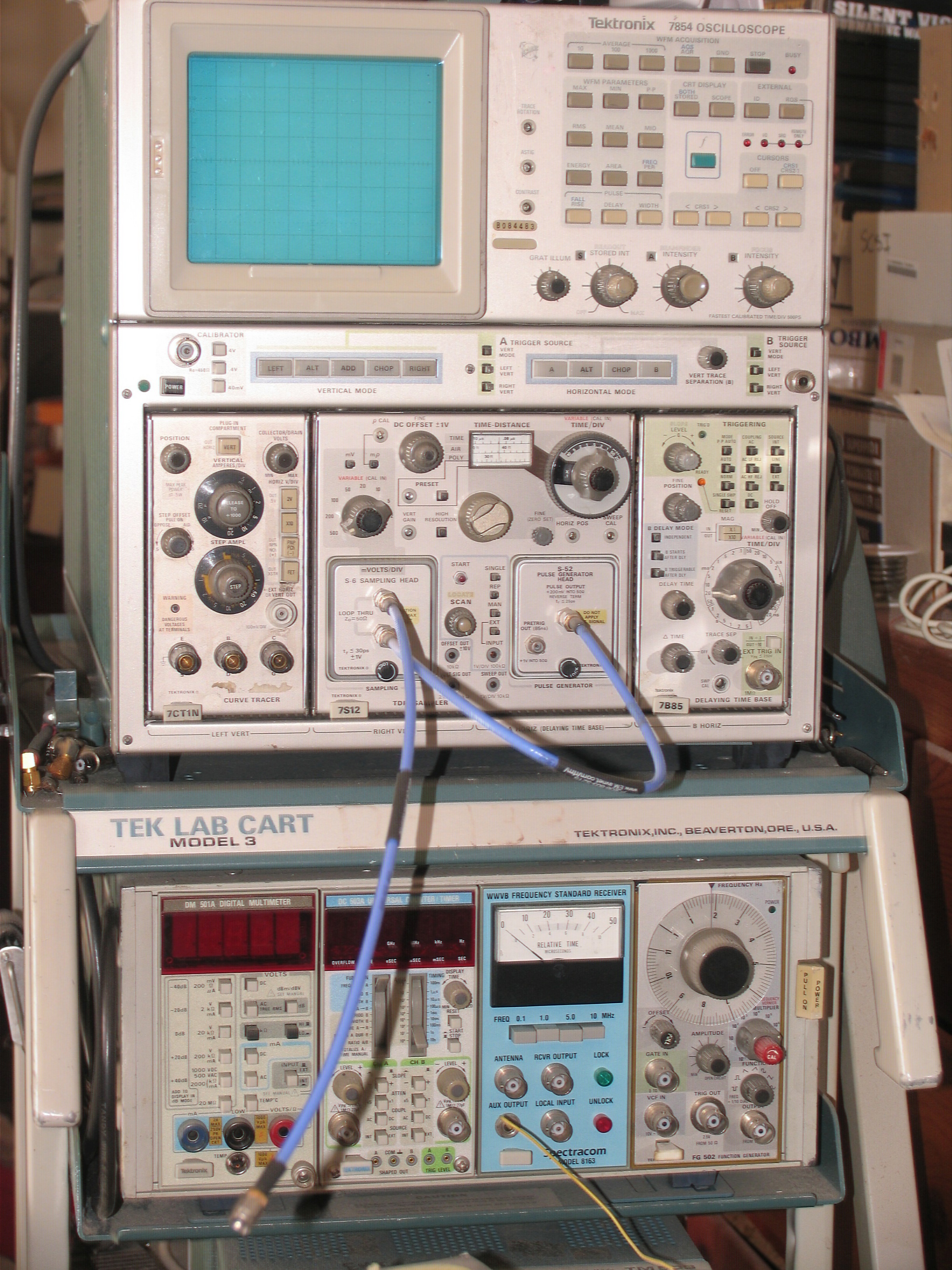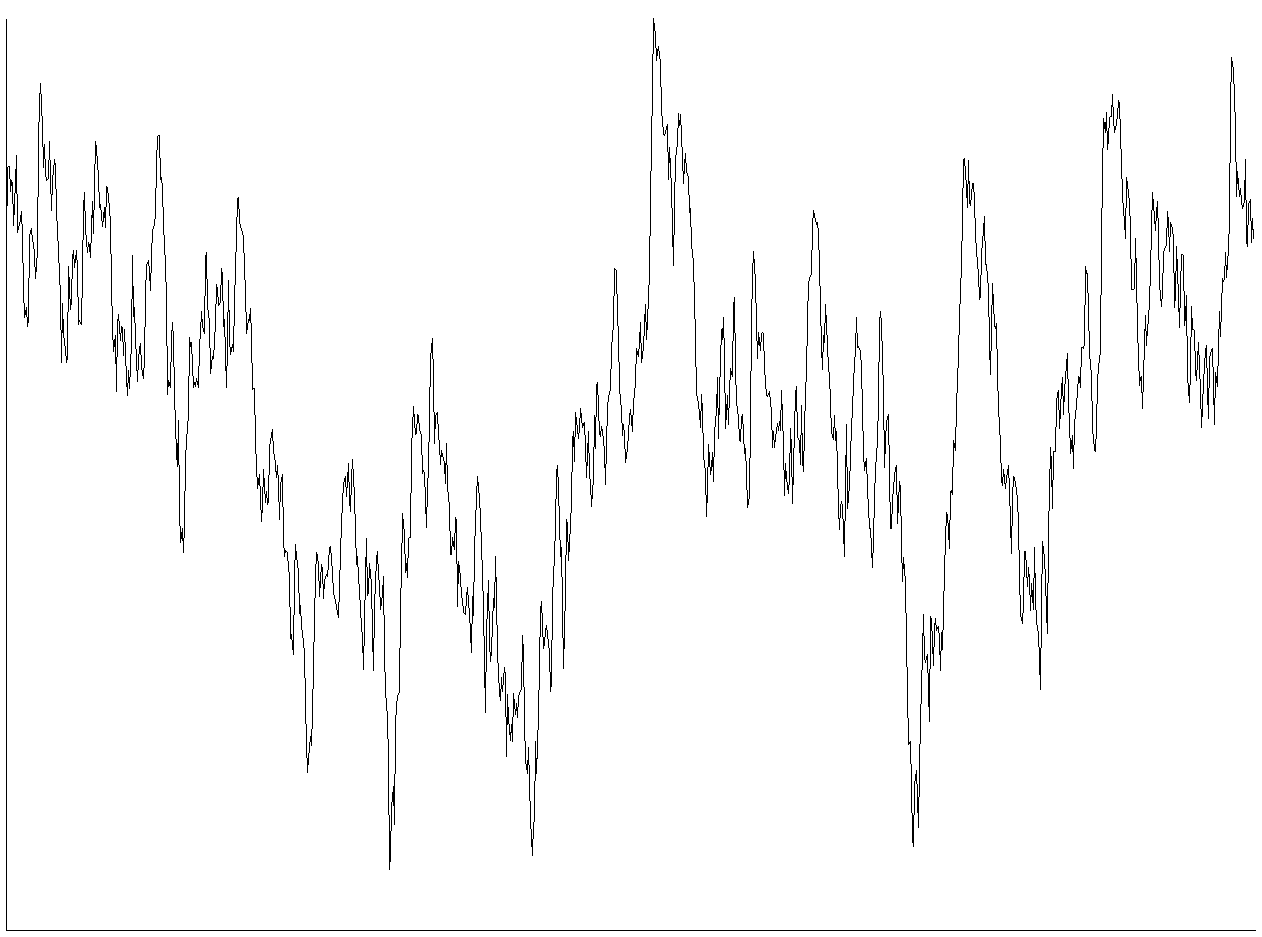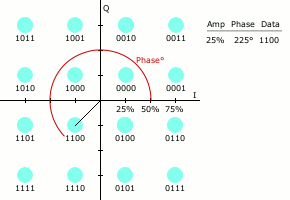|
Constellation Diagram
A constellation diagram is a representation of a signal modulated by a digital modulation scheme such as quadrature amplitude modulation or phase-shift keying. It displays the signal as a two-dimensional ''xy''-plane scatter diagram in the complex plane at symbol sampling instants. In a manner similar to that of a phasor diagram, the angle of a point, measured counterclockwise from the horizontal axis, represents the phase shift of the carrier wave from a reference phase; the distance of a point from the origin represents a measure of the amplitude or power of the signal. In a digital modulation system, information is transmitted as a series of samples, each occupying a uniform time slot. During each sample, the carrier wave has a constant amplitude and phase, which is restricted to one of a finite number of values. So each sample encodes one of a finite number of "symbols", which in turn represent one or more binary digits (bits) of information. Each symbol is encoded as ... [...More Info...] [...Related Items...] OR: [Wikipedia] [Google] [Baidu] |
8PSK Gray Coded
Phase-shift keying (PSK) is a digital modulation process which conveys data by changing (modulating) the phase of a constant frequency reference signal (the carrier wave). The modulation is accomplished by varying the sine and cosine inputs at a precise time. It is widely used for wireless LANs, RFID and Bluetooth communication. Any digital modulation scheme uses a finite number of distinct signals to represent digital data. PSK uses a finite number of phases, each assigned a unique pattern of binary digits. Usually, each phase encodes an equal number of bits. Each pattern of bits forms the symbol that is represented by the particular phase. The demodulator, which is designed specifically for the symbol-set used by the modulator, determines the phase of the received signal and maps it back to the symbol it represents, thus recovering the original data. This requires the receiver to be able to compare the phase of the received signal to a reference signal such a system is termed ... [...More Info...] [...Related Items...] OR: [Wikipedia] [Google] [Baidu] |
16QAM Gray Coded
Quadrature amplitude modulation (QAM) is the name of a family of digital modulation methods and a related family of analog modulation methods widely used in modern telecommunications to transmit information. It conveys two analog message signals, or two digital bit streams, by changing (''modulating'') the amplitudes of two carrier waves, using the amplitude-shift keying (ASK) digital modulation scheme or amplitude modulation (AM) analog modulation scheme. The two carrier waves are of the same frequency and are out of phase with each other by 90°, a condition known as orthogonality or quadrature. The transmitted signal is created by adding the two carrier waves together. At the receiver, the two waves can be coherently separated (demodulated) because of their orthogonality property. Another key property is that the modulations are low-frequency/low-bandwidth waveforms compared to the carrier frequency, which is known as the narrowband assumption. Phase modulation (analog PM) ... [...More Info...] [...Related Items...] OR: [Wikipedia] [Google] [Baidu] |
Vector Signal Analyzer
A vector signal analyzer is an instrument that measures the magnitude and phase of the input signal at a single frequency within the Intermediate frequency, IF Bandwidth (signal processing), bandwidth of the instrument. The primary use is to make in-channel measurements, such as error vector magnitude, code domain power, and spectral flatness, on known signals. Vector signal analyzers are useful in measuring and Demodulation, demodulating Modulation#Digital modulation methods, digitally modulated signals like W-CDMA (UMTS), W-CDMA, 3GPP Long Term Evolution, LTE, and Wireless LAN, WLAN. These measurements are used to determine the quality of modulation and can be used for design validation and compliance testing of electronic devices. Operation The vector signal analyzer spectrum analysis process typically has a down-convert & digitizing stage and a digital signal processing, DSP & display stage. Down-convert and digitize stage A vector signal analyzer operates by first down-conve ... [...More Info...] [...Related Items...] OR: [Wikipedia] [Google] [Baidu] |
Electronic Test Instrument
Electronic test equipment is used to create signals and capture responses from electronic devices under test (DUTs). In this way, the proper operation of the DUT can be proven or faults in the device can be traced. Use of electronic test equipment is essential to any serious work on electronics systems. Practical electronics engineering and assembly requires the use of many different kinds of electronic test equipment ranging from the very simple and inexpensive (such as a test light consisting of just a light bulb and a test lead) to extremely complex and sophisticated such as automatic test equipment (ATE). ATE often includes many of these instruments in real and simulated forms. Generally, more advanced test gear is necessary when developing circuits and systems than is needed when doing production testing or when troubleshooting existing production units in the field. Types of test equipment Basic equipment The following items are used for basic measurement of voltages, cur ... [...More Info...] [...Related Items...] OR: [Wikipedia] [Google] [Baidu] |
Distortion
In signal processing, distortion is the alteration of the original shape (or other characteristic) of a signal. In communications and electronics it means the alteration of the waveform of an information-bearing signal, such as an audio signal representing sound or a video signal representing images, in an electronic device or communication channel. Distortion is usually unwanted, and so engineers strive to eliminate or minimize it. In some situations, however, distortion may be desirable. For example, in noise reduction systems like the Dolby system, an audio signal is deliberately distorted in ways that emphasize aspects of the signal that are subject to electrical noise, then it is symmetrically "undistorted" after passing through a noisy communication channel, reducing the noise in the received signal. Distortion is also used as a musical effect, particularly with electric guitars. The addition of noise or other outside signals ( hum, interference) is not co ... [...More Info...] [...Related Items...] OR: [Wikipedia] [Google] [Baidu] |
Electronic Noise
In electronics, noise is an unwanted disturbance in an electrical signal. Noise generated by electronic devices varies greatly as it is produced by several different effects. In particular, noise is inherent in physics, and central to thermodynamics. Any conductor with electrical resistance will generate thermal noise inherently. The final elimination of thermal noise in electronics can only be achieved cryogenically, and even then quantum noise would remain inherent. Electronic noise is a common component of noise in signal processing. In communication systems, noise is an error or undesired random disturbance of a useful information signal in a communication channel. The noise is a summation of unwanted or disturbing energy from natural and sometimes man-made sources. Noise is, however, typically distinguished from interference, for example in the signal-to-noise ratio (SNR), signal-to-interference ratio (SIR) and signal-to-noise plus interference ratio (SNIR ... [...More Info...] [...Related Items...] OR: [Wikipedia] [Google] [Baidu] |
Communication Channel
A communication channel refers either to a physical transmission medium such as a wire, or to a logical connection over a multiplexed medium such as a radio channel in telecommunications and computer networking. A channel is used for information transfer of, for example, a digital bit stream, from one or several '' senders'' to one or several '' receivers''. A channel has a certain capacity for transmitting information, often measured by its bandwidth in Hz or its data rate in bits per second. Communicating an information signal across distance requires some form of pathway or medium. These pathways, called communication channels, use two types of media: Transmission line (e.g. twisted-pair, coaxial, and fiber-optic cable) and broadcast (e.g. microwave, satellite, radio, and infrared). In information theory, a channel refers to a theoretical ''channel model'' with certain error characteristics. In this more general view, a storage device is also a communication cha ... [...More Info...] [...Related Items...] OR: [Wikipedia] [Google] [Baidu] |
Phase-shift Keying
Phase-shift keying (PSK) is a digital modulation process which conveys data by changing (modulating) the phase of a constant frequency reference signal (the carrier wave). The modulation is accomplished by varying the sine and cosine inputs at a precise time. It is widely used for wireless LANs, RFID and Bluetooth communication. Any digital modulation scheme uses a finite number of distinct signals to represent digital data. PSK uses a finite number of phases, each assigned a unique pattern of binary digits. Usually, each phase encodes an equal number of bits. Each pattern of bits forms the symbol that is represented by the particular phase. The demodulator, which is designed specifically for the symbol-set used by the modulator, determines the phase of the received signal and maps it back to the symbol it represents, thus recovering the original data. This requires the receiver to be able to compare the phase of the received signal to a reference signal such a system is t ... [...More Info...] [...Related Items...] OR: [Wikipedia] [Google] [Baidu] |
Quadrature Amplitude Modulation
Quadrature amplitude modulation (QAM) is the name of a family of digital modulation methods and a related family of analog modulation methods widely used in modern telecommunications to transmit information. It conveys two analog message signals, or two digital bit streams, by changing (''modulating'') the amplitudes of two carrier waves, using the amplitude-shift keying (ASK) digital modulation scheme or amplitude modulation (AM) analog modulation scheme. The two carrier waves are of the same frequency and are out of phase with each other by 90°, a condition known as orthogonality or quadrature. The transmitted signal is created by adding the two carrier waves together. At the receiver, the two waves can be coherently separated (demodulated) because of their orthogonality property. Another key property is that the modulations are low-frequency/low-bandwidth waveforms compared to the carrier frequency, which is known as the narrowband assumption. Phase modulation (anal ... [...More Info...] [...Related Items...] OR: [Wikipedia] [Google] [Baidu] |
Coherent Detector
A carrier recovery system is a circuit used to estimate and compensate for frequency and phase differences between a received signal's carrier wave and the receiver's local oscillator for the purpose of coherent demodulation. In the transmitter of a communications carrier system, a carrier wave is modulated by a baseband signal. At the receiver, the baseband information is extracted from the incoming modulated waveform. In an ideal communications system, the carrier signal oscillators of the transmitter and receiver would be perfectly matched in frequency and phase, thereby permitting perfect coherent demodulation of the modulated baseband signal. However, transmitters and receivers rarely share the same carrier oscillator. Communications receiver systems are usually independent of transmitting systems and contain their oscillators with frequency and phase offsets and instabilities. Doppler shift may also contribute to frequency differences in mobile radio frequency communica ... [...More Info...] [...Related Items...] OR: [Wikipedia] [Google] [Baidu] |
Imaginary Number
An imaginary number is a real number multiplied by the imaginary unit , is usually used in engineering contexts where has other meanings (such as electrical current) which is defined by its property . The square of an imaginary number is . For example, is an imaginary number, and its square is . By definition, zero is considered to be both real and imaginary. Originally coined in the 17th century by René Descartes as a derogatory term and regarded as fictitious or useless, the concept gained wide acceptance following the work of Leonhard Euler (in the 18th century) and Augustin-Louis Cauchy and Carl Friedrich Gauss (in the early 19th century). An imaginary number can be added to a real number to form a complex number of the form , where the real numbers and are called, respectively, the ''real part'' and the ''imaginary part'' of the complex number. History Although the Greek mathematician and engineer Hero of Alexandria is noted as the first to present a calculation ... [...More Info...] [...Related Items...] OR: [Wikipedia] [Google] [Baidu] |



